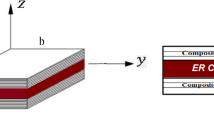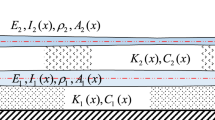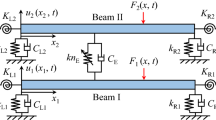The paper summarizes the findings of a study of the influence of stiffness parameters of an elastic restraint in a damaged regular system consisting of two duplicate elements and modeling a two-blade assembly, on the generation of vibration of the system under fundamental resonance. A discrete dual-mass model whose vibration is described by a nonlinear set of differential equations of second order has been chosen as a design model of the structurally regular system under consideration. Numerical investigations have been performed using the Runge-Kutta method to solve a nonlinear set of differential equations and the fast Fourier transform method to process the solutions obtained. The dependences of the resonant frequency ratios and resonant amplitude ratios of the first-harmonic vibration on the damage parameter have been derived for the discrete model of the regular system in inphase and antiphase modes, with different parameters of the elastic restraint for the damaged subsystem and for the intact one. It is demonstrated that with a preset value of the damage parameter the frequencies of the inphase and antiphase modes grow with increasing coefficient of the elastic restraint of the subsystems. This influence is the most significant in the case of the antiphase mode of vibration of the subsystems. The elastic restraint coefficient has also a substantial effect on the level of resonant amplitudes of the first-harmonic vibration for the regular-system model under study. It has been found out that as the elastic restraint coefficient grows the resonant amplitude of the intact subsystem increases under the inphase-mode vibration and decreases under the antiphase one. The values of the resonant amplitudes of vibration of the damaged subsystem are influenced by the coefficient to a lesser extent. The maximum value of the resonant amplitudes of vibration of the damaged subsystem is almost independent of the elastic restraint coefficient.








Similar content being viewed by others
References
V. A. Kruts, A. P. Zinkovskii, and E. A. Sinenko, “Influence of a fatigue crack on the vibrations of the simplest regular elastic system,” Strength Mater., 45, No. 3, 308–315 (2013).
I. G. Tokar’ and A. P. Zinkovskii, “Influence of the parameters of local defect in a regular system on the range of eigenfrequencies of vibrations and the level of vibration stresses in elements of the same type,” Strength Mater., 42, No. 2, 167–174 (2010).
B.-W. Huang and J.-H. Kuang, “Vibration in the stability of a rotating blade disk with a local crack defect,” J. Sound Vib., 294, No. 3, 486–502 (2006).
A. P. Zinkovskii, I. G. Tokar’, and V. A. Kruts, “Influence of the local surface damage parameters on the natural frequencies of vibration of structural elements,” Strength Mater., 47, No. 2, 221–226 (2015).
A. P. Zinkovskii, V. A. Kruts, E. A. Onyshchenko, and I. G. Tokar, “Vibrations of structural elements with local surface damage,” in: Proc. of the XII Int. Conf. on Vibration Engineering and Technology of Machinery (September 7–9, 2016, Warsaw) (2016), pp. 187–194.
V. V. Matveev, “Approximate analytical determination of vibrodiagnostic parameters of non-linearity of elastic bodies due to the presence of closing crack. Part. 2. Determination of diagnostic parameters in principal and 2-nd order superharmonic resonances,” Strength Mater., 36, No. 5, 449–462 (2004).
V. V. Matveev, O. E. Boginich, and A. P. Yakovlev, “Approximate analytical method for determining the vibration-diagnostic parameter indicating the presence of a crack in a distributed-parameter elastic system at super- and subharmonic resonances,” Strength Mater., 42, No. 5, 528–543 (2010).
V. V. Matveev, A. P. Yakovlev, O. E. Boginich, and E. A. Sinenko, “Approximate analytical determination of vibrodiagnostic parameters of the presence of a closing crack in bar elements under subharmonic resonance,” Strength Mater., 46, No. 3, 315–327 (2014).
E. A. Sinenko and A. P. Zinkovskii, “Influence of the exciting force application point on the amplitude spectrum of flexural vibrations in a beam with a “breathing” crack,” Strength Mater., 47, No. 4, 553–560 (2015).
V. V. Matveev, O. E. Boginich, E. A. Sinenko, and A. P. Yakovlev, “On vibrodiagnostics of the presence of a closing edge crack in a beam with amplitude-dependent damping capacity under superharmonic resonance,” Strength Mater., 47, No. 5, 653–661 (2015).
A. Ya. Adamenko, I. G. Tokar’, and V. V. Matveev, “A method of examining the damping capacity of vanes of turbomachines under the effect of temperature and centrifugal forces,” Strength Mater., 15, No. 7, 949–953 (1983).
O. O. Larin, “Forced vibrations of bladings with the random technological mistuning,” in: Proc. of the ASME Turbo Expo 2010 (June 14–18, 2010, Glasgow), Glasgow (2010), pp. 667–672.
Author information
Authors and Affiliations
Additional information
Translated from Problemy Prochnosti, No. 6, pp. 38 – 48, November – December, 2018.
Rights and permissions
About this article
Cite this article
Kruts, V.A. The Influence of Stiffness of Elastic Restraint in a Damaged Regular System on Its Resonant Vibration. Strength Mater 50, 859–867 (2018). https://doi.org/10.1007/s11223-019-00032-5
Received:
Published:
Issue Date:
DOI: https://doi.org/10.1007/s11223-019-00032-5




